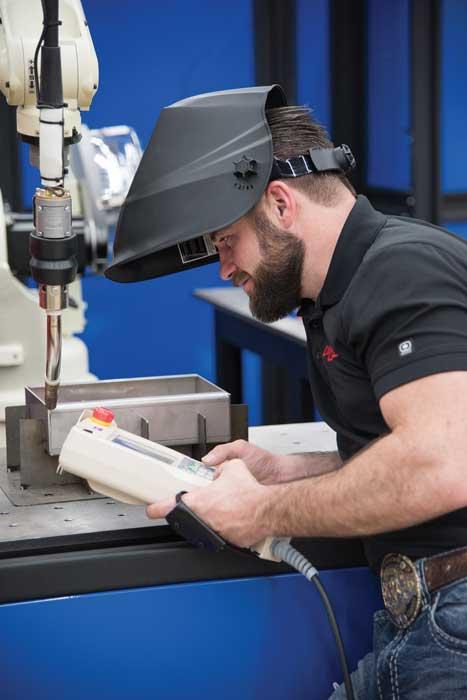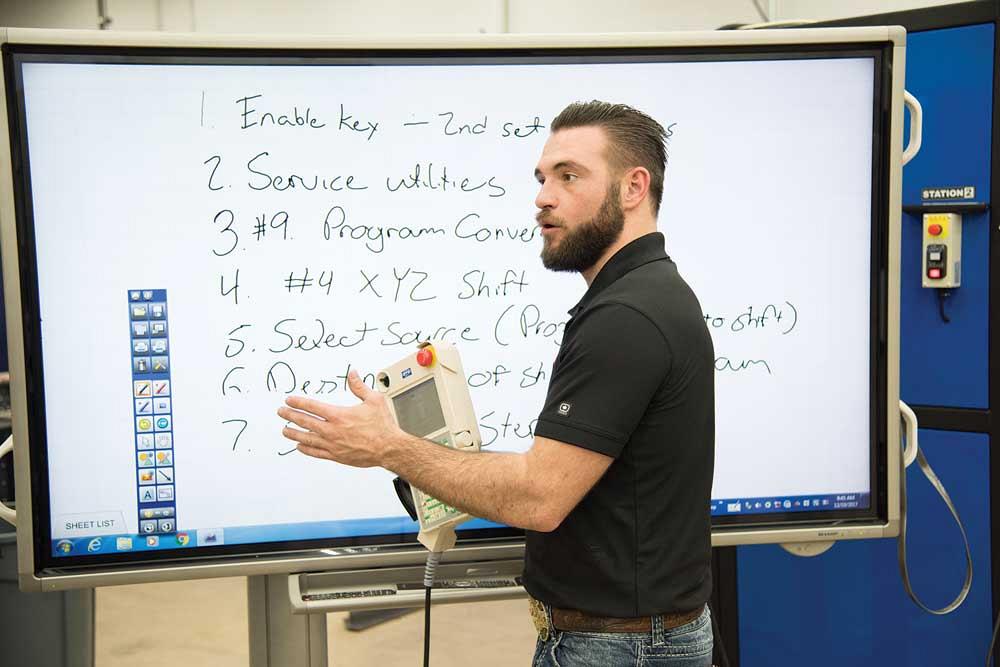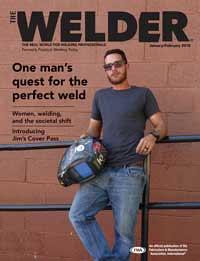- FMA
- The Fabricator
- FABTECH
- Canadian Metalworking
Categories
- Additive Manufacturing
- Aluminum Welding
- Arc Welding
- Assembly and Joining
- Automation and Robotics
- Bending and Forming
- Consumables
- Cutting and Weld Prep
- Electric Vehicles
- En Español
- Finishing
- Hydroforming
- Laser Cutting
- Laser Welding
- Machining
- Manufacturing Software
- Materials Handling
- Metals/Materials
- Oxyfuel Cutting
- Plasma Cutting
- Power Tools
- Punching and Other Holemaking
- Roll Forming
- Safety
- Sawing
- Shearing
- Shop Management
- Testing and Measuring
- Tube and Pipe Fabrication
- Tube and Pipe Production
- Waterjet Cutting
Industry Directory
Webcasts
Podcasts
FAB 40
Advertise
Subscribe
Account Login
Search
Catching up with Brennan Palmiter
He's made the jump from driving an FMA-sponsored race car to working with robotic welding cells
- By Amanda Carlson
- January 20, 2018
- Article
- Arc Welding

In 2008, 16-year-old Brennan Palmiter was a race car driver, welding enthusiast, and spokesperson for young people in the trades. Now 25, Palmiter is all grown up and embarking on a career in robotic welding systems.
Brennan Palmiter was 16 years old when he was first introduced to the readers of Practical Welding Today®. He was a race car driver, a spokesman for the trades, and a dynamo on his way to earning an associate degree and a high school diploma at the same time.
Much has happened in nine years. Now 25, Palmiter made the decision to let go of his dream of becoming a race car driver to follow a new path. He’s still as energetic as he ever was and passionate about welding and manufacturing. Currently he is gearing up for a move to Dallas to start a career at Capital Robotics, a subsidiary of Capital Machine Technologies, where he gets to merge his welding knowledge with a keen interest in technology and robotics.
Palmiter recently spoke with The WELDER® about life, his new career, and the lessons he’s learned through his many experiences over the last nine years.
TW: Catch us up on what you’ve been doing since 2009.
When I turned 18 I felt the desire to serve my country, so I gave up racing and enlisted in the Marine Corps. I went to Afghanistan in 2012 and did another deployment to Japan where I got to help train coalition forces. I spent five years in the Marine Corps. It was a great experience, and it was a lot of what I thought I needed. I grew up around military families and always idolized their service and sacrifice, so it was a big honor for me to get to do that. But as soon as I got home, I went right back to welding and building race cars. My first job after I got back was building roll cages in Southern California.
TW: How did the military help prepare you for the next stage of your life, both professionally and personally?
The Marine Corps helped me grow up a lot. I don’t think I had a bad work ethic before I enlisted, but that experience definitely has helped me refine my ability to focus on the task at hand. When I got home, I noticed that the little things that used to frustrate me before I went in were a lot easier to put my head down and get through after I got out.
TW: How did you get connected with Capital Robotics, and what are your responsibilities there?
I was working with a welding supply company in California when I realized I wanted to work with robotics, so I found a recruiter who mentioned Capital Robotics. I got an interview with them and got to see all the robotic welding systems they had in-house as well as the type of technology they were working with. It seemed like a great fit.
As a robotics welding applications engineer I’ll be working with customers and evaluating their applications to see if they could potentially use a robot to reduce their cost per part or increase their production capabilities. I’ll be identifying what customers’ needs might be and how a robot could be a benefit to their manufacturing environment, how they can save money, and how they can increase production. So, that’s one side of things. The other side is I’ll be heavily involved with on-site training, installations, and working with the welders who get to program and use the equipment day to day.

Palmiter spent five years in the Marine Corps, an experience that sent him to places like Afghanistan and Japan. As soon as he came home he went right back to welding.
TW: What do you say to the folks who are concerned that implementing robotics will replace people?
The thing about robotic welding is you can’t be successful without knowing how to weld. You have to be familiar with torch angles, stick-out, voltage, amperage where it pertains to the type of material that you’re welding, the different types of gases that you can and can’t use, and the type of filler material you need. All of the things that you need to know to be a good manual welder are the exact same things that will make your robotic welding process successful.
I try to drive home the fact that a robot is a piece of equipment that exists to make your life easier, but you can’t run it without knowing how to weld. A welder can watch the puddle and knows, just by looking at it, when there needs to be more amperage, or when the travel speed needs to be higher because the bead has cold toes or too much spatter. It doesn’t eliminate welders at all, it just makes them more productive.
TW: Are there any other misconceptions surrounding robotic welding that you’ve encountered on the job?
Some companies think they can give the robot their most complex projects, when actually they can’t. You want to give robots simple, monotonous tasks that will free up your welder to perform more complex work. Another misconception is that young people make great robotic welding operators because it’s like working a Game Boy. As a younger guy, that assumption kind of upsets me. Personally, I’m terrible at video games because I can’t sit still for very long. My take is that technology doesn’t scare young people. They are excited to be a part of technology; it gets their minds running. That’s who I am and why I’m excited about what I’m doing now.
TW: Do the stereotypes about millennials annoy you?
On one hand I hate the millennial stereotype, but on the other hand I understand it. You can easily look at some millennials and say, “You’re lazy.” But I’m also proud of my generation for its ability to adopt technology without fear. Of course, there’s a certain percentage of my generation that are bad apples, and unfortunately it’s the bad apples that get the press while the good, hardworking ones don’t. I run into young, hardworking, highly motivated millennials all of the time. If you look around the manufacturing industry you’ll find a bunch of them who have entered the industry at 18 years old, have worked their butts off, and really made something of their lives.
I don’t get mad about the stereotypes. I think people can figure out very quickly after meeting me and talking with me that I don’t fit that stereotype at all. I grew up in a shop, so I’m a shop kid through and through. I love to work, I love problem solving, and I love working with my hands and building things. I was raised by good parents who taught me a lot about taking pride in everything that you do and working hard. If you do those two things, there’s not much bad people can say about you as long as you do right.
TW: What advice would you give to young people who are currently involved in welding and manufacturing, or who want to be involved someday?
Never get stuck in your ways. Be open to trying different things because there may be a better way than what you’re doing. For up and coming kids, I still have the same message now as I did when I was visiting all those schools when I was a teenager: You don’t have to have a bachelor’s degree to make a really great living. I earned an associate degree when I was 17, and all I’ve done since then is continue to learn and grow within welding and manufacturing. I’ve learned a ton of lessons along the way, and I’m carrying each one of those experiences with me into this next phase of my life. Even though I’m not on a shop floor welding, everything that I have learned about welding has helped me to excel.
Photos courtesy of Blake Photography, Dallas, Texas.
About the Author

Amanda Carlson
2135 Point Blvd
Elgin, IL 60123
815-227-8260
Amanda Carlson was named as the editor for The WELDER in January 2017. She is responsible for coordinating and writing or editing all of the magazine’s editorial content. Before joining The WELDER, Amanda was a news editor for two years, coordinating and editing all product and industry news items for several publications and thefabricator.com.
About the Publication
subscribe now

The Welder, formerly known as Practical Welding Today, is a showcase of the real people who make the products we use and work with every day. This magazine has served the welding community in North America well for more than 20 years.
start your free subscription- Stay connected from anywhere

Easily access valuable industry resources now with full access to the digital edition of The Fabricator.

Easily access valuable industry resources now with full access to the digital edition of The Welder.

Easily access valuable industry resources now with full access to the digital edition of The Tube and Pipe Journal.
- Podcasting
- Podcast:
- The Fabricator Podcast
- Published:
- 04/16/2024
- Running Time:
- 63:29
In this episode of The Fabricator Podcast, Caleb Chamberlain, co-founder and CEO of OSH Cut, discusses his company’s...
- Trending Articles
Sheffield Forgemasters makes global leap in welding technology

Welding student from Utah to represent the U.S. at WorldSkills 2024

Lincoln Electric announces executive appointments

Lincoln Electric acquires RedViking

Engine-driven welding machines include integrated air compressors

- Industry Events
16th Annual Safety Conference
- April 30 - May 1, 2024
- Elgin,
Pipe and Tube Conference
- May 21 - 22, 2024
- Omaha, NE
World-Class Roll Forming Workshop
- June 5 - 6, 2024
- Louisville, KY
Advanced Laser Application Workshop
- June 25 - 27, 2024
- Novi, MI



























